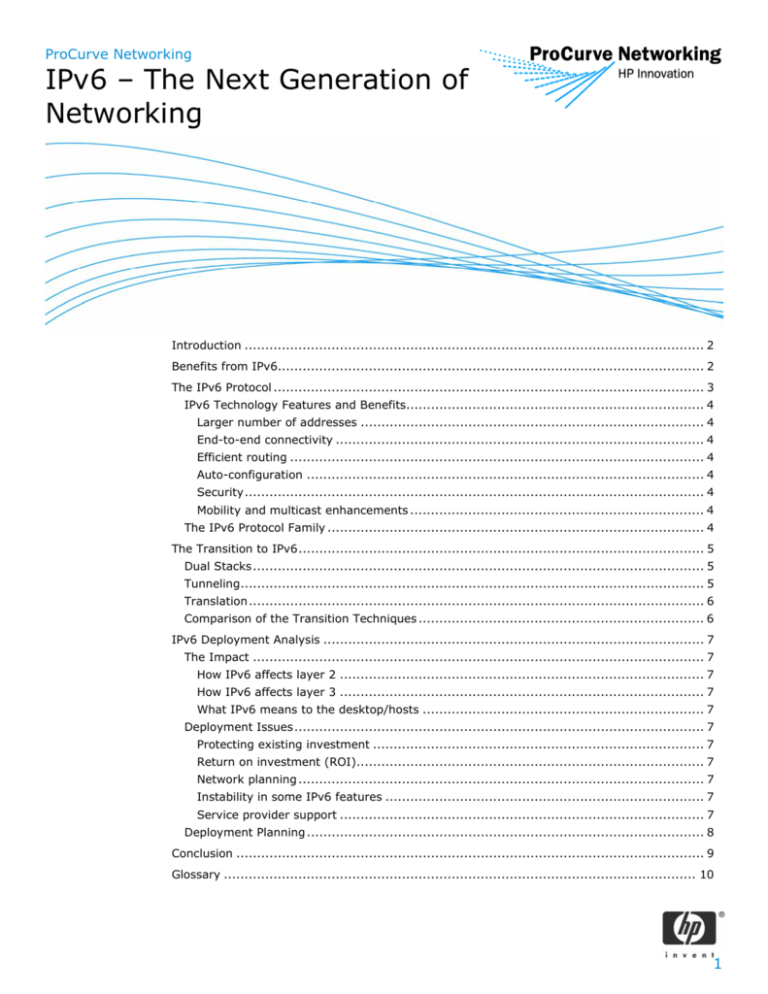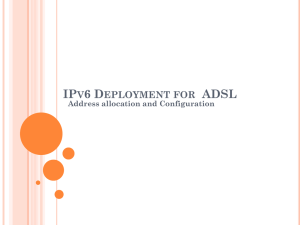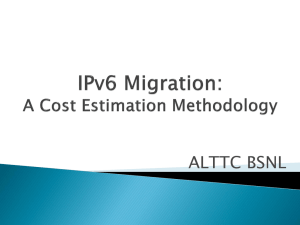IPv6-The Next Generation in Networking - Hewlett
advertisement

ProCurve Networking IPv6 – The Next Generation of Networking Introduction ............................................................................................................... 2 Benefits from IPv6....................................................................................................... 2 The IPv6 Protocol ........................................................................................................ 3 IPv6 Technology Features and Benefits........................................................................ 4 Larger number of addresses ................................................................................... 4 End-to-end connectivity ......................................................................................... 4 Efficient routing .................................................................................................... 4 Auto-configuration ................................................................................................ 4 Security............................................................................................................... 4 Mobility and multicast enhancements ....................................................................... 4 The IPv6 Protocol Family ........................................................................................... 4 The Transition to IPv6.................................................................................................. 5 Dual Stacks............................................................................................................. 5 Tunneling................................................................................................................ 5 Translation.............................................................................................................. 6 Comparison of the Transition Techniques ..................................................................... 6 IPv6 Deployment Analysis ............................................................................................ 7 The Impact ............................................................................................................. 7 How IPv6 affects layer 2 ........................................................................................ 7 How IPv6 affects layer 3 ........................................................................................ 7 What IPv6 means to the desktop/hosts .................................................................... 7 Deployment Issues................................................................................................... 7 Protecting existing investment ................................................................................ 7 Return on investment (ROI).................................................................................... 7 Network planning .................................................................................................. 7 Instability in some IPv6 features ............................................................................. 7 Service provider support ........................................................................................ 7 Deployment Planning ................................................................................................ 8 Conclusion ................................................................................................................. 9 Glossary .................................................................................................................. 10 1 Introduction IPv4 (or IP, as it is known) is the basis of the TCP/IP communication protocols which are used to transport data, voice and video packets over the Internet. Internet Protocol version 6 (IPv6) is the next generation network protocol which has been standardized to replace the current Internet protocol version 4. It holds great promise to be the backbone of the next generation Internet and offer a significant improvement over IPv4 in terms of scalability, security, mobility and convergence. The basic framework of the IPv6 protocol was standardized by IETF (Internet Engineering Task Force) in the 1990s. However, there is still ongoing development of certain advanced aspects of the protocol. This paper provides an introduction to IPv6 by discussing the potential business benefits resulting from deploying IPv6 technology. To understand how we get these benefits, we look into some of the technical features and advantages of IPv6. We then look at the transition mechanisms developed to enable a seamless migration from IPv4 to IPv6. Finally, we analyze some deployment issues and strategies to prepare an adoption plan for deploying IPv6 in an enterprise. Benefits from IPv6 The new features of IPv6 result in a number of business benefits: o Lower network administration costs: The auto-configuration and hierarchical addressing features of IPv6 will make networks easy to manage. o Optimized for next generation networks: Getting rid of NAT re-enables the peer-to-peer model and helps in deploying new applications. E.g. communications and mobility solutions such as VoIP o Protection of company assets: Integrated IPSEC makes IPv6 inherently secure and provides for a unified security strategy for the entire network. o Investment protection: The transition and translation suite of protocols helps in easy and planned migration from IPv4 and IPv6, while allowing for co-existence in the transition phase. 2 The IPv6 Protocol The basic IPv6 protocol has a different packet header structure as compared to IPv4. This is best illustrated using a picture: Version Hd. Len. TOS Identification TTL Total Packet Length Flags Protocol Fragment Offset Header Checksum 20 bytes Source IP Address Destination IP Address Options n bytes Padding 32 bits Figure 1 IPv4 header Version Traffic Class Flow Label Payload Length Next Header Hop Limit Source IP Address 40 bytes Destination IP Address 32 bits Figure 2 IPv6 header As can be seen, the header is simplified. The options have been restructured to follow the header and are no longer part of the header. This makes IPv6 header processing at intermediate nodes much easier. A new “flow label” field has been added to provide enhanced QoS in the future. The specific benefits resulting from the new header definition are listed in the next section. 3 IPv6 Technology Features and Benefits Let us look at what technical features IPv6 adds beyond IPv4 and what benefits they provide: Larger number of addresses IPv6 has 128 bit addresses, as compared to 32 bits for IPv4 addresses. This results in a very large increase in the number of IP addresses available and has a number of advantages. It gets rid of scenarios where there is an IP address scarcity and NAT needs to be deployed to fix the issue. Getting rid of NAT results in a simplified network configuration and it reduced hardware and software complexity. The large number of IPv6 addresses also helps in the future vision of a networked home where various appliances and gadgets in a home will be networked and manageable over the Internet. The increasing deployment of wireless and mobile devices will also not be cramped by IP address scarcity issues. End-to-end connectivity IPv4 needed NAT in certain situations in order to conserve scarce IP addresses. Unfortunately, NAT does not work well with peer-to-peer applications like VoIP. IPv6 eliminates the need for NAT and thus restores end-to-end connectivity. As a result, peer-to-peer applications work well with IPv6. Also, certain higher layer protocols like FTP have a similar issue with NAT and need specialized software to work through NAT. Such application protocols like FTP can be enabled much more easily with IPv6. Efficient routing IPv6 has a more streamlined header as compared to IPv4. This reduces the processing overhead for routers resulting in less hardware complexity and faster packet processing. Also, hierarchical addressing in IPv6 allows for proper address space allocation resulting in smaller routing tables and more efficient routing in the overall network. It also makes it easier for network administrators to assign/track addresses. Auto-configuration IPv6 provides auto-configuration of IP addresses on IPv6-enabled devices. This greatly improves scalability and manageability of networks. New devices can be directly connected to the network without manually configuring IP addresses or having a DHCP server. Also, administrators can easily migrate a large number of devices from one network to another. Security IPv6 makes IPSEC mandatory, thus providing a solid security framework for Internet communication. IPSEC can be used to implement both encryption and authentication. A number of IPv4 implementations do not enable IPSEC, thus resulting in less security. Mobility and multicast enhancements IPv6 provides further enhancements for mobile IPv6 which helps with today’s wireless networks. The addition of scope field for multicast has improved the framework for multicast traffic. Also, the IPv6 anycast address type can be used for efficient host location. The IPv6 Protocol Family IPv6 is not just a single isolated protocol. IPv6 encompasses a family of protocols which will augment/replace the existing IPv4 family of protocols. The IPv6 protocol family includes the basic IPv6 protocol with its new addressing architecture. It also includes a vastly expanded ICMPv6 protocol which provides autoconfiguration and neighbor discovery (similar to the ARP functionality in IPv4), Path MTU discovery (important because only originating node can fragment packets in IPv6), error and informational messaging (including pingv6), multicast Listener discovery (similar to IGMP for IPv4) and mobile IPv6 related functionality. DHCPv6 is the new version of DHCP for IPv6. Note that since IPv6 supports autoconfiguration of IP addresses, DHCPv6 is not always required. DHCPv6 has been completely redesigned and is only conceptually similar to DHCP. It also has additional functionality such as server originated reconfiguration and authentication. The interior routing protocols for IPv6 include RIPng (next generation RIP) and OSPFv3. The RIPng protocol is very similar to RIPV2 and has been adapted to advertise IPv6 network prefixes. Thus, RIPng is a very simple routing protocol suitable for use in small to medium IPv6 networks 4 with similar tradeoffs as with RIPV2. The OSPFv3 protocol is a link state routing protocol based on OSPFv2 with a number of modifications (e.g. support for IPv6 prefixes, OSPFv3 runs over a link rather than a subnet, each LSA has a flooding scope, removal of OSPF authentication by now relying on the inherent security provided by IPv6-IPSEC). It follows the “ships-in-the-night” approach, i.e. a typical deployment will need both OSPFv2 and OSPFv3. OSPFv3 will exchange IPv6 routing information while OSPFv2 will exchange IPv4 routing information. The Transition to IPv6 The big question is not whether IPv6 will be widely deployed successfully in the Internet – it is how and when. There are three transition mechanisms available to deploy IPv6 on IPv4 networks and they may be used in any combination: Dual Stacks In this method, both IPv4 and IPv6 co-exist on a device/node. Depending on which node it is talking to, the application will use IPv4 or IPv6 as appropriate. This may also be determined by the DNS response to a node-name. If DNS returns a v4 address, IPv4 will be used. If DNS returns a v6 address, IPv6 will be used. IPv4/v6 Dual Stack Node IPv6 Application on IPv6 Node IPv4 Stack IPv4/ IPV6 Application IPv6 Stack IPv4 Application on IPv4 Node Figure 3 Dual Stack Method Tunneling The tunneling mechanism encapsulates IPv6 packets in IPv4 packets and can be used by 2 IPv6 nodes to communicate with each other over an IPv4 network. There are 2 ways to do tunneling: Automatic tunneling uses IPv4-compatible IPv6 addresses to add a route to a special IPv6 prefix which points to a tunnel destination. Any packets destined for a v4-compatible address will be sent through the tunnel. In Configured tunneling, the address of the tunnel exit point is configured on the tunnel entry point and similar encapsulation is used. A combination of automatic and configured tunneling can also be used to route IPv6 packets across a v4 network. Teredo, ISATAP, 6to4 and 6over4 are other tunneling mechanisms. Teredo encapsulates IPv6 packets over UDP which allows them to pass through NAT nodes. ISATAP can be used by v6 hosts on a v4 network without any IPv6 routers using a specially constructed ISATAP address. 6to4 also uses a special prefix for tunneling. 5 IPv4 Network IPv6 Host IPv6 Host IPv6 Packet IPv6 packet encapsulated in IPv4 packet IPv6 Packet Figure 4 IPv6 tunneling Translation Address and protocol translation mechanisms such as NAT-PT (Network Address translation – protocol translation) and SIIT (Stateless IP-ICMP translation) can be used to help an IPv6 host talk to an IPv4 host, by converting v6 packets into v4 and vice-versa. IPv4 Network IPv6 Host IPv4 Host IPv6 Packet IPv4 Packet IPv4 Packet Figure 5 IPv6 translation Comparison of the Transition Techniques The dual stack method is easy to use and flexible. However, it needs two IP stacks and has to maintain 2 processing tables and needs more memory. Also, applications must be able to determine whether the peer is using IPv4 or IPv6. Tunneling allows gradual deployment of IPv6 even without IPv6 support from an ISP since you can communicate using IPv6 over a v4 network. Disadvantages are typical of other tunneling mechanisms; tunnel entry/exit points need to perform extra work and can be single points of failure. The translation techniques are really needed if there is a specific need such as going through a NAT device and this method may be unable to use enhanced v6 features. Thus, there are multiple methods to transition to IPv6 and different business requirements may lead to different 6 network plans deploying various transition technologies. Enterprises will need to research their specific needs and network scenarios to figure out what works best for them. IPv6 Deployment Analysis The Impact of IPv6 on Various Network Entities How IPv6 affects layer 2 The layer 2 switches process packets based on MAC addresses which are independent of IPv6. Hence, implementing IPv6 over layer 2 networks should not need significant changes to the layer 2 switches. However, IPv6 support for protocol VLANs may need hardware support. Functionality such as ACL (Access Control Lists) and MLD snooping (equivalent to IPv4 IGMP snooping) will need to take into account changes for IPv6. How IPv6 affects layer 3 For layer 3 support, in addition to the basic IPv6 modules, the routing and forwarding mechanism needs to be aware of IPv6. Hence, protocols such as RIPng and OSPFv3 will need to be deployed and the hardware will need to be IPv6 capable in order to do line rate processing of IPv6 packets. Thus, a significant change to hardware and software functionality will be needed in routers to support IPv6. What IPv6 means to the desktop/hosts The desktop operating system needs to support IPv6 in order to deploy IPv6 on hosts. The enterprise and consumer applications need to be ported to IPv6 so that there is an application base for IPv6. New IPv6 applications will need to be developed that support end-to-end and peer-to-peer communications models on the Internet. For hosts to communicate using IPv6, the necessary infrastructure needs to be in place to support IPv6. A transition plan needs to be formulated for the network and the strategy will figure out whether the transition will need specific software support from the host or whether it will be seamless. Again, depending on the network topology plan, DHCP or DNS support may be needed. Deployment Issues IPv6 technology promises to bring a number of benefits to network communications. But given the complexity of the entire IPv6 protocol family and the need for a robust infrastructure supporting the protocols, it would be wise for an enterprise to give thoughtful consideration to issues concerning IPv6 deployment. Protecting existing investment Vendors need to protect existing investments in switches/routers/hosts. Thus they need a strategy which will maximize the returns on current investments Return on investment (ROI) IPv6 will need software and hardware upgrades on hosts, switches and routers. It may need deployment of new applications. Also, IPv6 transition needs to be carefully planned and a pilot network is typically done to evaluate the strategy. All this requires time and adds to expenses. Hence, a clear business case needs to be made to trigger migration of enterprise networks to IPv6. Network planning IPv6 can be deployed in two ways: having completely independent IPv6 and IPv4 networks or overlaying IPv4 and IPv6 networks. This strategy can affect the IPv6 features required on hosts, switches and routers. Instability in some IPv6 features Certain standards like mobile IPv6, flow label are not stable yet, and this is necessary for successful deployment particularly to avoid interoperability issues. Service provider support For enterprises which require IPv6 communication over the Internet, it is necessary to look into what IPv6 services and applications are offered by the service providers. 7 Deployment Planning The initial network deployment in enterprises would typically be done as pilot projects in test environments to gain comfort in understanding and operation of IPv6. In addition to host/routing IPv6 products, it will be necessary to analyze the required management, applications, middleware and security infrastructure required in the final network. IPv6 Host Layer 2 Bridged Network IPv6 Switch IPv6 Switch IPv6 Host Figure 6 IPv6 layer 2 bridged network A typical deployment strategy may be to introduce IPv6 functionality in stages. Initially, IPv6 host functionality may be deployed on end nodes routers in order to gain familiarity with IPv6 issues. The host functionality would provide basic IPv6 connectivity. In the next stage, layer 2 IPv6 switching could be deployed to allow end-nodes to communicate over the same network and to evaluate how end-to-end IPv6 applications interact. In the final stage, IPv6 routing can be deployed to have full IPv6 network facility. Transition technologies can then be deployed to have interoperability between IPv4 and IPv6, depending on the transition strategy. RFC 4057 discusses in further detail enterprise network planning for IPv6. IPv6 Host Layer 3 Routed Network IPv6 Router IPv6 Router IPv6 Host Figure 7 IPv6 layer 3 routed network While analyzing a large scale network, it will be useful to understand what kind of networking (layer 2 vs. layer 3) is deployed at various parts (core, distribution, edge). This will help in understanding which IPv6 features will be needed at what place in the network. In one scenario, only the core may be doing layer 3 routing and the distribution and edge may be layer 2. In this 8 case, the distribution/edge products will probably need IPv6 host and layer 2 related IPv6 features (e.g. MLD), while the core may need IPv6 host, routing and IPv6 translation and transition features. In a second scenario, layer 3 may be deployed in core/distribution/edge. In this case, the distribution/edge products may need IPv6 host and routing and the core may need IPv6 routing and IPv6 translation and transition. Scenario 1 Scenario 2 Core – L3 IPv6 host, routing, transition Core – L3 IPv6 host, routing, transition Edge – L2 - IPv6 host, IPv6 L2 features (e.g. MLD ) Edge – L3 - IPv6 host, routing Figure 8 IPv6 needs at network core/edge Conclusion IPv6 will be the critical backbone of next generation networking technology. It holds tremendous promise, yet enterprises and businesses need a carefully planned evaluation and transition strategy for IPv6. Looking forward to the future, enterprises must carefully plan their investment in networking equipment to make sure the IPv6 is deployed in a sequential and planned manner, while making sure that the investments are justified. The potential business benefits resulting from IPv6 include lower network administration costs, protection of company assets via unified security model, investment protection by phased transition and deployment of new applications. 9 Glossary IETF – Internet Engineering Task Force IPv4 – Internet Protocol version 4 IPv6 – Internet Protocol version 6 DHCP – Dynamic Host Configuration Protocol DNS – Domain Name System NAT – Network Address Translation ICMP – Internet Control Message Protocol IGMP – Internet Group Management Protocol MTU – Maximum Transmission Unit NDP – Neighbor Discovery Protocol MLD – Multicast Listener Discovery ISATAP – Intra-site Automatic Tunnel Addressing Protocol NAT-PT – Network Address Translation – Protocol Translation SIIT – Stateless IP-ICMP Translation VoIP – Voice over IP OSPFv3 – Open Shortest Path First Version 3 RIPng – Routing Information Protocol – Next Generation To find out more about ProCurve Networking products and solutions, visit our web site at www.procurve.com © 2006 Hewlett-Packard Development Company, L.P. The information contained herein is subject to change without notice. The only warranties for HP products and services are set forth in the express warranty statements accompanying such products and services. Nothing herein should be construed as constituting an additional warranty. HP shall not be liable for technical or editorial errors or omissions contained herein. 4AA0-4810ENW, 03/2006 10





